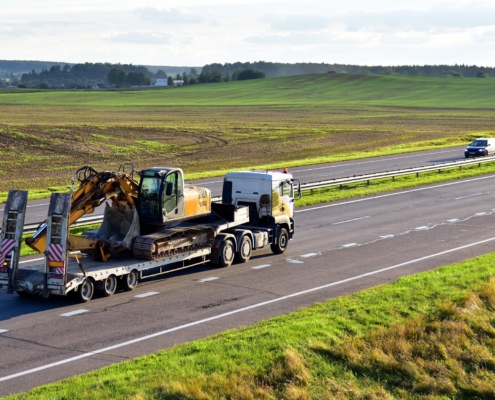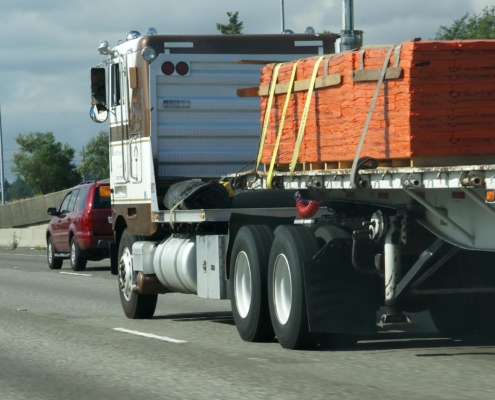Best Practices for Flatbed Partial Load Shipments
When it comes to optimizing your shipping processes and ensuring safety and cost-efficiency in transport, understanding the best practices for flatbed partial load shipments is crucial.
When it comes to optimizing your shipping processes and ensuring safety and cost-efficiency in transport, understanding the best practices for flatbed partial load shipments is crucial.
When it comes to moving bulky or oversized items, flatbed partial load shipping becomes a go-to for many businesses. This shipping method allows for the transportation of goods that don’t require the space of a full truckload, making it a cost-effective solution. By sharing the flatbed trailer with other shipments, companies can significantly reduce shipping costs without sacrificing efficiency.
The beauty of partial truckload shipments lies in their flexibility. Whether you’re dealing with construction materials, large machinery, or any non-standard-sized items, flatbed partial loads can accommodate a wide range of cargo sizes and shapes. This adaptability makes it an ideal choice for loads moved today that don’t fit within the constraints of traditional freight shipping.
The unique advantage of partial truckload shipping is its ability to handle cargo that doesn’t conform to standard dimensions. Unlike full truckload (FTL) or less-than-truckload (LTL) shipments, partial truckloads offer the flexibility to ship larger, irregularly shaped items. When assessing if your cargo is suitable for partial load shipping, think about whether it would benefit from the open space and versatile loading options of a flatbed trailer.
Every shipping method comes with its own set of regulations, and partial truckload is no exception. It’s crucial to understand and comply with these regulations to ensure safe and legal transportation of your goods. This can include securing permits for oversized loads or adhering to specific route restrictions. Knowing these regulations will not only keep your cargo safe but also avoid potential fines or delays in shipping.
To optimize your shipping costs and prevent any issues during transport, accurately measuring and weighing your cargo is imperative. In the realm of flatbed partial loads, this information helps logistics providers plan the best way to load and secure your shipment alongside others. It also influences the cost of your shipment, as rates can vary based on weight and space taken up on the trailer. Remember, inaccurate information can lead to unexpected charges or delays.
Make the right choice for your third-party shipping needs the first time around. Knowing what to evaluate in a potential partner is key to finding the solutions that fit your goals.
Now that we’ve covered the essentials, let’s highlight some best practices to ensure the smooth shipping of your flatbed partial loads. Choosing the right carrier, securing your load adequately, and maintaining open lines of communication are pivotal steps in this process.
Selecting a carrier that specializes in partial truckload shipments can significantly impact the success of your shipping process. Look for logistics providers with experience in handling similar types of cargo and who offer competitive rates. Additionally, consider carriers that leverage advanced technology for tracking and efficient route planning, as this can further reduce shipping times.
Comparing rates and services from multiple carriers is also advisable. Take advantage of load boards and digital freight marketplaces to find the best deals for your partial shipments.
Properly securing and packaging your load is critical to prevent damage during transit. Use straps, chains, and other securing devices as needed, based on the size and type of your cargo. Tarps may also be necessary to protect your shipment from the elements. Remember, the goal is to ensure that your cargo arrives in the same condition it was shipped.
Investing time in proper load securing can save you from potential losses and claims issues. It’s also a regulatory requirement and a critical step in safeguarding your goods en route.
Maintaining regular communication with your carrier is crucial for a smooth shipping process. This includes being clear about your shipping requirements, expected delivery times, and any special handling your cargo might need. Additionally, take advantage of tracking services offered by your carrier to monitor your shipment’s progress.
Effective communication can help address any issues promptly, ensuring your shipment arrives on time and in good condition. It’s not just about moving cargo; it’s about building a partnership with your carrier to achieve the best outcomes for your logistics needs.
Several key factors need to be considered to ensure the successful shipping of flatbed partial loads. The weight and size of the load, the freight class and density, and the required equipment and preparation for your shipment play crucial roles in the process. Let’s explore why these factors matter.
The weight and size of your load not only determine the type of trailer needed but also affect the cost of shipping. For partial loads, the ability to fit your shipment with others on a single flatbed is essential for optimized trailer utilization. This efficient use of space leads to reduced shipping times compared to shipping smaller shipments independently.
Understand that exceeding certain weight or size limitations can push your shipment into a different freight class or necessitate additional permits, affecting overall shipping costs. Always aim for accuracy in your load’s dimensions and weight.
Freight classes are essential in determining your shipping costs. The classification depends on the size, weight, density, and ease of handling of your cargo. Higher freight classes typically imply higher rates. Knowing your freight class helps you better estimate shipping costs and compare rates across different carriers.
Density, or the space your item occupies in relation to its weight, is a key factor in determining freight class. Items that are heavy for their size tend to have lower freight classes, meaning lower shipping costs. Accurately calculating your cargo’s density can lead to significant savings.
Preparation is key to successful flatbed partial load shipments. This includes having the right equipment on hand, such as tarps, straps, and edge protectors, to secure your cargo properly. The right preparation ensures your shipment arrives safely and intact, minimizing the risk of damage during transit.
Additionally, consider any special requirements your cargo may have. For example, oversized loads might require special permits or escorts. Partnering with a logistics provider experienced in partial truckload shipments can help streamline this process, allowing you to focus on other aspects of your business.
When you need a safe solution that prevents damage to your cargo, turn to a shipping company like Noble Choice Logistics. We offer straightforward shipping services for whatever your business needs. Contact us today for a free consultation.








Noble Choice Logistics simplifies and optimizes shipping operations for outfits across North America and beyond. We embrace the latest technologies to be a resource to our partners and stand out as a pillar in the freight world.
This site uses cookies. By continuing to browse the site, you are agreeing to our use of cookies.
AcceptLearn moreWe may request cookies to be set on your device. We use cookies to let us know when you visit our websites, how you interact with us, to enrich your user experience, and to customize your relationship with our website.
Click on the different category headings to find out more. You can also change some of your preferences. Note that blocking some types of cookies may impact your experience on our websites and the services we are able to offer.
These cookies are strictly necessary to provide you with services available through our website and to use some of its features.
Because these cookies are strictly necessary to deliver the website, refusing them will have impact how our site functions. You always can block or delete cookies by changing your browser settings and force blocking all cookies on this website. But this will always prompt you to accept/refuse cookies when revisiting our site.
We fully respect if you want to refuse cookies but to avoid asking you again and again kindly allow us to store a cookie for that. You are free to opt out any time or opt in for other cookies to get a better experience. If you refuse cookies we will remove all set cookies in our domain.
We provide you with a list of stored cookies on your computer in our domain so you can check what we stored. Due to security reasons we are not able to show or modify cookies from other domains. You can check these in your browser security settings.
We also use different external services like Google Webfonts, Google Maps, and external Video providers. Since these providers may collect personal data like your IP address we allow you to block them here. Please be aware that this might heavily reduce the functionality and appearance of our site. Changes will take effect once you reload the page.
Google Webfont Settings:
Google Map Settings:
Google reCaptcha Settings:
Vimeo and Youtube video embeds:
